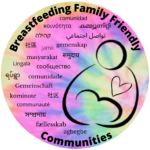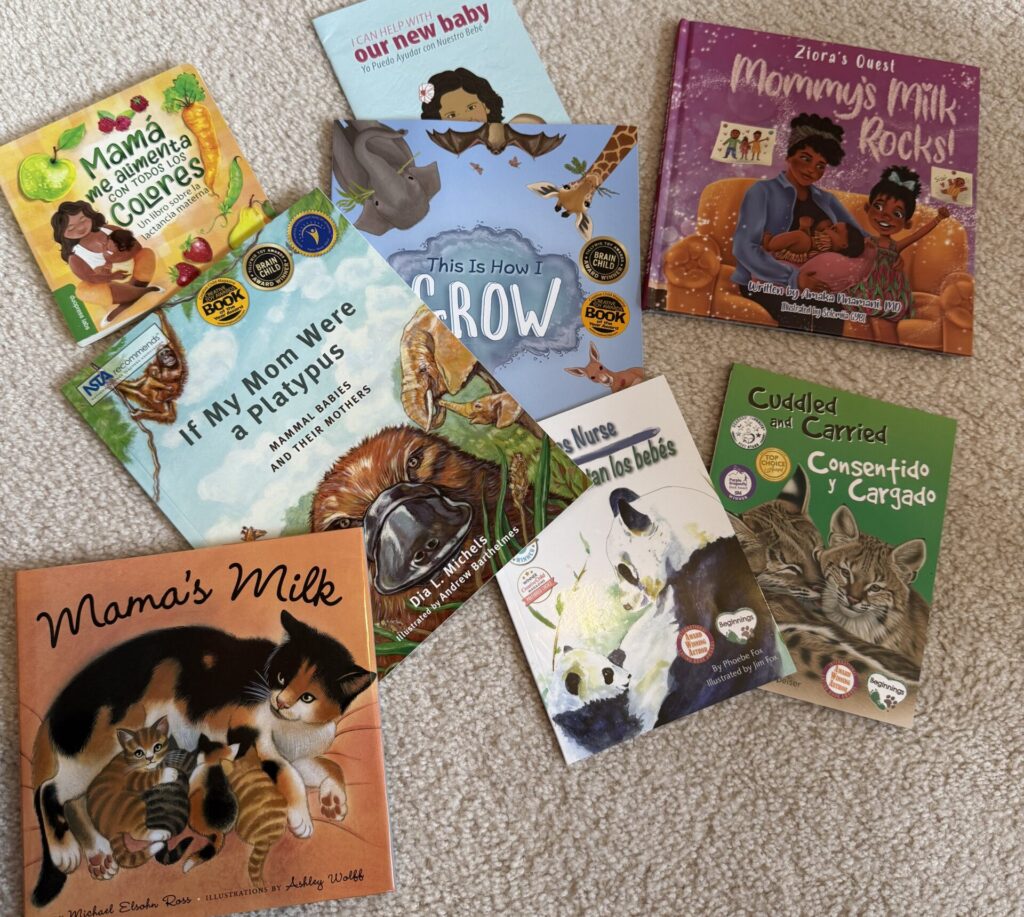One of the most challenging aspects of the Breastfeeding Family Friendly Communities (BFFC) journey is Step 10: ensuring that chest/breastfeeding is normalized within the curriculum of K-12 schools, childcare centers, colleges, and universities. For chest/breastfeeding to become the normative behavior, it’s essential that people of all ages, from young children to adults, are exposed to it through education.
Rationale: Why Step 10 Matters
To foster a culture where chest/breastfeeding is seen as a natural and normal part of life, it must be represented in health and family education curricula. This includes images, books, and discussions about breastfeeding to help create a society that embraces it.
Within our pilot city, Breastfeed Durham we are working closely with local school systems and librarians to ensure chest/breastfeeding is represented in their educational materials. One of our primary questions is: What books are available that promote and normalize chest/breastfeeding?
Book List by Age Group: Breastfeeding-Friendly Literature
We’ve compiled a list of books that positively promote breastfeeding, all sorted by age group. These books can be used by educators, parents, and students alike to foster understanding and support for breastfeeding. From picture books for young children to more in-depth reads for older students, these selections offer a great way to encourage a culture that embraces chest/breastfeeding.
Books for Early Childhood (Pre-K – Grade 8)
- All the World
- A Mammal is an Animal by Lizzie Rockwell
- Babies Nurse by Phoebe Fox
- Born in the Wild
- Cuddled and Carried / Consentido y cargado by Dia Michels – Bilingual edition available
- If My Mom Were a Platypus by Dia Michels
- Magical Milk by Nasheeda Pollard
- Mama Feeds Me All the Colors by Duopress Labs
- Mama’s Leche by Michelle Hackney – Spanish edition available
- Mama’s Milk by Michael Elsohn Ross
- Mama, Who Drinks Milk Like Me? by Melissa Panter
- Many Mommies Make Milk by Ann Hoffman
- Mommy Feeds Baby by Christy Jo Hendricks – Recommended for home use
- My New Baby by Rachel Fuller – Single racial representation
- The Best Gifts by Marsha Forchuk Skrypuch
- Welcome to the Big Kids Club by Chelsea Clinton
- Who in the World Likes to Nurse
- Will There be a Lap for Me?
- Ziora’s Quest: Mommy’s Milk Rocks by Nasheeda Pollard
Books by Grade Level
Grades K-1:
- Cuddled and Carried by Dia Michels
- The Best Gifts by Marsha Forchuk Skrypuch
- Babies Nurse by Phoebe Fox
- Mama’s Milk by Michael Elsohn Ross
- Mama Feeds Me All the Colors by Duopress Labs
- Mama’s Leche by Michelle Hackney – Spanish edition available
Grades 1-3:
- Ziora’s Quest: Mommy’s Milk Rocks by Nasheeda Pollard
- Mama, Who Drinks Milk Like Me? by Melissa Panter
- A Mammal is an Animal by Lizzie Rockwell
Grades 3-4:
- Magical Milk by Nasheeda Pollard
- Welcome to the Big Kids Club by Chelsea Clinton
Grades 5-8:
- If My Mom Were a Platypus by Dia Michels
- Mommy Feeds Baby by Christy Jo Hendricks – Recommended for home use
Step 10: Normalizing Chest/Breastfeeding in Education Systems
Step 10 of the BFFC initiative emphasizes the need for educational systems—including childcare, K-12 schools, colleges, and universities—to incorporate chest/breastfeeding-friendly curricula. This helps normalize breastfeeding as part of health and family education, ensuring that individuals of all ages see breastfeeding as the normative behavior.
Measures for Success in Step 10:
- School districts or departments of education provide books and images that depict chest/breastfeeding as a normal practice.
- Chest/breastfeeding-friendly curricula are introduced at every level of education.
Suggested Approaches:
- Teams approach heads of educational systems to discuss the integration of chest/breastfeeding into curricula.
- Documentation of the presence of chest/breastfeeding in educational content—whether through books, class discussions, or images—is the key to success.
By including chest/breastfeeding-friendly books and curricula in educational systems, we can help ensure that future generations grow up understanding and supporting breastfeeding as a natural, healthy, and normal way to nurture babies.

